Day-588
Quiz-summary
0 of 5 questions completed
Questions:
- 1
- 2
- 3
- 4
- 5
Information
DAILY MCQ
You have already completed the quiz before. Hence you can not start it again.
Quiz is loading...
You must sign in or sign up to start the quiz.
You have to finish following quiz, to start this quiz:
Results
0 of 5 questions answered correctly
Your time:
Time has elapsed
You have reached 0 of 0 points, (0)
Categories
- Not categorized 0%
- 1
- 2
- 3
- 4
- 5
- Answered
- Review
-
Question 1 of 5
1. Question
1. Consider the following:
1. Cultivation of algae in oceans
2. Pumping surface water down to the deep ocean
3. Marine cloud brightening
4. Loading minerals like basalt into the ocean
How many of the above are ocean-based Carbon Dioxide Removal Technologies (CDR for abating climate change?Correct
Answer. C
Explanation: Options 1, 2 and 4 are correct.
Geoengineering strategies can be classified as solar radiation management (SRM) or Carbon dioxide Removal Technologies (CDR). Marine cloud brightening is a method exploited for solar radiation management (it does not involve the removal of CO2 and its storage/conversion into bio-based products etc.). Rather, marine cloud brightening harnesses natural processes, using sea spray to increase the amount of light and heat that clouds deflect from the sun, to cool and shade the coral reef below. Microscopic sea water droplets are sprayed into the air, creating a mild fog which deflects solar energy. It also seeds the clouds, increasing their capacity to deflect sunlight.

Carbon removal, also known as negative emissions strategies, includes natural solutions like relying on forests, marshes or soil to trap and store carbon, or the deployment of emerging technology to pull carbon directly from the air or ocean, and then, storing it long term. There is a swelling interest in exploring ocean-based CDR technologies.
Proposals include massively boosting the production of seaweeds like kelp (algae), which absorb carbon during photosynthesis, before sinking it into the deep sea or turning it into a climate-friendly seafood or bioplastic.
Others involve pumping surface water down to the deep ocean where increased pressure and solubility allow more carbon to be stored. Or alternatively, pushing cold, nutrient-rich water up from the deep to spur the growth of plankton that absorb carbon before sinking to deeper water when they die.
A related strategy is to fertilize the ocean with iron or nitrogen to trigger large plankton blooms.
Scrubbing carbon from the air or stripping it from ocean water before injecting it into the deep sea or seabed, or boosting the ocean’s alkalinity and ability to absorb carbon by loading it with minerals like basalt or carbonate are also being explored.Incorrect
Answer. C
Explanation: Options 1, 2 and 4 are correct.
Geoengineering strategies can be classified as solar radiation management (SRM) or Carbon dioxide Removal Technologies (CDR). Marine cloud brightening is a method exploited for solar radiation management (it does not involve the removal of CO2 and its storage/conversion into bio-based products etc.). Rather, marine cloud brightening harnesses natural processes, using sea spray to increase the amount of light and heat that clouds deflect from the sun, to cool and shade the coral reef below. Microscopic sea water droplets are sprayed into the air, creating a mild fog which deflects solar energy. It also seeds the clouds, increasing their capacity to deflect sunlight.


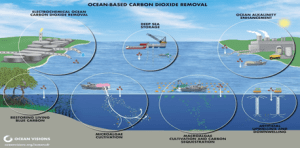
Carbon removal, also known as negative emissions strategies, includes natural solutions like relying on forests, marshes or soil to trap and store carbon, or the deployment of emerging technology to pull carbon directly from the air or ocean, and then, storing it long term. There is a swelling interest in exploring ocean-based CDR technologies.
Proposals include massively boosting the production of seaweeds like kelp (algae), which absorb carbon during photosynthesis, before sinking it into the deep sea or turning it into a climate-friendly seafood or bioplastic.
Others involve pumping surface water down to the deep ocean where increased pressure and solubility allow more carbon to be stored. Or alternatively, pushing cold, nutrient-rich water up from the deep to spur the growth of plankton that absorb carbon before sinking to deeper water when they die.
A related strategy is to fertilize the ocean with iron or nitrogen to trigger large plankton blooms.
Scrubbing carbon from the air or stripping it from ocean water before injecting it into the deep sea or seabed, or boosting the ocean’s alkalinity and ability to absorb carbon by loading it with minerals like basalt or carbonate are also being explored. -
Question 2 of 5
2. Question
2. Consider the following:
1. Ring-tailed lemur
2. Hog deer
3. Hoolock Gibbon
4. Markhor
How many of the above species are naturally found in India?Correct
Answer: C
Explanation:
Option 1 is incorrect: Ring-tailed lemur is an endangered species of primate which is endemic to the island of Madagascar. It is not naturally found in India. rather, this exotic species can be spotted in India only in some zoos Mysuru zoo, etc.).



Option 2 is correct: Hog deer is naturally found in India. Two sub-species of hog deer have been reported from its range. The western race is distributed from Pakistan and the terai grasslands (along the Himalayan foothills, from Punjab to Arunachal Pradesh), while the eastern race of hog deer is found in Thailand, Indo-China, Laos, Cambodia, and Vietnam. The western limit of hog deer in India is in Manipur.
The hog deer or Pada is an endangered species in the IUCN Red List and is protected under Schedule I of the Indian Wild Life (Protection) Act, 1972.
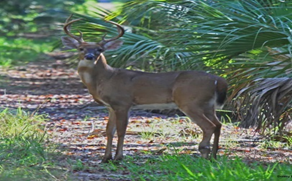
Option 3 is correct: Hoolock gibbon is naturally found in India. it is endemic to the Northeastern states of India.
Gibbons, the smallest and fastest of all apes, live in tropical and subtropical forests in the southeastern part of Asia. The hoolock gibbon, unique to India’s northeast, is one of 20 species of gibbons on Earth. Over the decades, zoologists thought the northeast housed two species of the ape — the eastern hoolock gibbon (Hoolock leuconedys) found in a specific region of Arunachal Pradesh and the western hoolock gibbon (Hoolock hoolock) distributed elsewhere in the northeast. A study led by Hyderabad-based Centre for Cellular and Molecular Biology (CCMB) in 2021 proved through genetic analysis that there is only one species of ape (Hoolock Gibbon) in India.


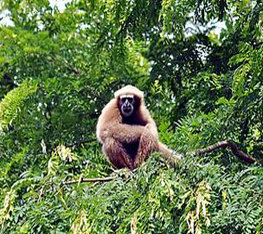
Option 4 is correct: Markhor is naturally found in India in the region of Kashmir only. The markhor Capra falconeri, is considered the world’s largest mountain goat.
Markhor in Persian means ‘snake-killer’, named so for its mythical power of killing snakes with its horns and eating them. However, like other goats, the markhor is actually a herbivore that grazes on grass and leaves on mountain cliffs and slopes. Scattered herds are found across the scrublands, open woodlands and mountains of central Asia, Karakoram and the Himalaya in Turkmenistan, Uzbekistan, Tajikistan, Afghanistan, Pakistan and northern India. Here, they are endemic only to Kashmir and found nowhere else in the country.
Out of the three Markhor subspecies recognised by the IUCN, the astor markhor or flare-horned markhor Capra falconeri falconeri is found in the Kashmir region. It is locally also recognised by another scientific name, Capra falconeri cashmiriensis or Kashmir markhor.


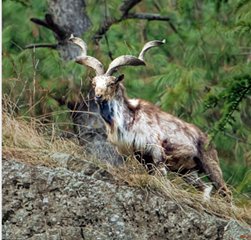 Incorrect
Incorrect
Answer: C
Explanation:
Option 1 is incorrect: Ring-tailed lemur is an endangered species of primate which is endemic to the island of Madagascar. It is not naturally found in India. rather, this exotic species can be spotted in India only in some zoos Mysuru zoo, etc.).



Option 2 is correct: Hog deer is naturally found in India. Two sub-species of hog deer have been reported from its range. The western race is distributed from Pakistan and the terai grasslands (along the Himalayan foothills, from Punjab to Arunachal Pradesh), while the eastern race of hog deer is found in Thailand, Indo-China, Laos, Cambodia, and Vietnam. The western limit of hog deer in India is in Manipur.
The hog deer or Pada is an endangered species in the IUCN Red List and is protected under Schedule I of the Indian Wild Life (Protection) Act, 1972.

Option 3 is correct: Hoolock gibbon is naturally found in India. it is endemic to the Northeastern states of India.
Gibbons, the smallest and fastest of all apes, live in tropical and subtropical forests in the southeastern part of Asia. The hoolock gibbon, unique to India’s northeast, is one of 20 species of gibbons on Earth. Over the decades, zoologists thought the northeast housed two species of the ape — the eastern hoolock gibbon (Hoolock leuconedys) found in a specific region of Arunachal Pradesh and the western hoolock gibbon (Hoolock hoolock) distributed elsewhere in the northeast. A study led by Hyderabad-based Centre for Cellular and Molecular Biology (CCMB) in 2021 proved through genetic analysis that there is only one species of ape (Hoolock Gibbon) in India.



Option 4 is correct: Markhor is naturally found in India in the region of Kashmir only. The markhor Capra falconeri, is considered the world’s largest mountain goat.
Markhor in Persian means ‘snake-killer’, named so for its mythical power of killing snakes with its horns and eating them. However, like other goats, the markhor is actually a herbivore that grazes on grass and leaves on mountain cliffs and slopes. Scattered herds are found across the scrublands, open woodlands and mountains of central Asia, Karakoram and the Himalaya in Turkmenistan, Uzbekistan, Tajikistan, Afghanistan, Pakistan and northern India. Here, they are endemic only to Kashmir and found nowhere else in the country.
Out of the three Markhor subspecies recognised by the IUCN, the astor markhor or flare-horned markhor Capra falconeri falconeri is found in the Kashmir region. It is locally also recognised by another scientific name, Capra falconeri cashmiriensis or Kashmir markhor.



-
Question 3 of 5
3. Question
3. With reference to the Indian laws about water governance, consider the following statements:
1. The groundwater quality assessment in the country is under the domain of the Central Water Commission (CWC).
2. The groundwater extraction and management through issuance of the No-Objection Certificates (NOCs) is done by the Central Ground Water Authority (CGWA).
Which of the statements given above is/are correct?Correct
Answer: B
Explanation:
Statement 1 is incorrect: The groundwater quality assessment in the country is under the domain of the Central Ground Water Board (CGWB) and not the Central Water Commission (CWC). The Central Ground Water Board (CGWB) has 16 Regional Chemical Laboratories to carry out chemical analysis of water samples. The Chemical laboratories are well equipped with sophisticated instruments like ICP-MS, Atomic Absorption Spectrophotometer (AAS) etc. Ground water sampling for quality monitoring is done once a year during the pre-monsoon period. In addition to it, ground water samples are also collected and analysed as a part of other scientific studies.
It must be noted that the CWC (presently functioning as an attached office of the Ministry of Jal Shakti, Department of Water Resources, River Development and Ganga Rejuvenation) is entrusted with the responsibility for water quality assessment of rivers in the country. The CWC assesses the quality of river water based on the physical parameters such as temperature, colour, odour electrical conductivity, total dissolved solids, pH and dissolved oxygen of river water.Statement 2 is correct: The Central Ground Water Authority (CGWA) regulates ground water development and management by issuing ‘No Objection Certificates’ (NOC) for ground water extraction to industries or infrastructure projects or Mining Projects etc. The Applicants who seek permission for Water Extraction may obtain services of the accredited individuals or institutions for conducting a hydrogeological survey and prepare a report on the ground water scenario and the impact of the proposed extraction on the ground water reservoir, which is mandatory for issuance of No Objection Certificate (NOC) from Central Ground Water Authority.
The CGWA is a statutory body established under Section 3 of the Environment Protection Act, 1986. It has been granted the powers to, amongst others, regulate and control, manage and develop ground water in the entire country and to issue necessary directions for this purpose.Incorrect
Answer: B
Explanation:
Statement 1 is incorrect: The groundwater quality assessment in the country is under the domain of the Central Ground Water Board (CGWB) and not the Central Water Commission (CWC). The Central Ground Water Board (CGWB) has 16 Regional Chemical Laboratories to carry out chemical analysis of water samples. The Chemical laboratories are well equipped with sophisticated instruments like ICP-MS, Atomic Absorption Spectrophotometer (AAS) etc. Ground water sampling for quality monitoring is done once a year during the pre-monsoon period. In addition to it, ground water samples are also collected and analysed as a part of other scientific studies.
It must be noted that the CWC (presently functioning as an attached office of the Ministry of Jal Shakti, Department of Water Resources, River Development and Ganga Rejuvenation) is entrusted with the responsibility for water quality assessment of rivers in the country. The CWC assesses the quality of river water based on the physical parameters such as temperature, colour, odour electrical conductivity, total dissolved solids, pH and dissolved oxygen of river water.Statement 2 is correct: The Central Ground Water Authority (CGWA) regulates ground water development and management by issuing ‘No Objection Certificates’ (NOC) for ground water extraction to industries or infrastructure projects or Mining Projects etc. The Applicants who seek permission for Water Extraction may obtain services of the accredited individuals or institutions for conducting a hydrogeological survey and prepare a report on the ground water scenario and the impact of the proposed extraction on the ground water reservoir, which is mandatory for issuance of No Objection Certificate (NOC) from Central Ground Water Authority.
The CGWA is a statutory body established under Section 3 of the Environment Protection Act, 1986. It has been granted the powers to, amongst others, regulate and control, manage and develop ground water in the entire country and to issue necessary directions for this purpose. -
Question 4 of 5
4. Question
4. Florianopolis declaration, often mentioned in the news, is:
Correct
Answer: B
Explanation:
The 67th meeting of the International Whaling Commission (IWC-67) adopted the Florianopolis Declaration, which affirms the continued moratorium against commercial whaling, and a Schedule amendment on aboriginal subsistence whaling.
In the non-binding Florianopolis Declaration, the IWC agrees that the Commission’s role in the 21st century includes its responsibility to ensure the recovery of cetacean populations to their preindustrial levels, and reaffirms the importance of maintaining the moratorium on commercial whaling. The Declaration acknowledges the abundance of contemporary non-lethal cetacean research methods and that the use of lethal research methods is unnecessary, and seeks to ensure that aboriginal subsistence whaling for the benefit of indigenous communities meets the Commission’s management and conservation objectives, taking into account the safety of hunters and the welfare of cetaceans.Incorrect
Answer: B
Explanation:
The 67th meeting of the International Whaling Commission (IWC-67) adopted the Florianopolis Declaration, which affirms the continued moratorium against commercial whaling, and a Schedule amendment on aboriginal subsistence whaling.
In the non-binding Florianopolis Declaration, the IWC agrees that the Commission’s role in the 21st century includes its responsibility to ensure the recovery of cetacean populations to their preindustrial levels, and reaffirms the importance of maintaining the moratorium on commercial whaling. The Declaration acknowledges the abundance of contemporary non-lethal cetacean research methods and that the use of lethal research methods is unnecessary, and seeks to ensure that aboriginal subsistence whaling for the benefit of indigenous communities meets the Commission’s management and conservation objectives, taking into account the safety of hunters and the welfare of cetaceans. -
Question 5 of 5
5. Question
5. Consider the following statements:
Statement I: The Central Pollution Control Board (CPCB) has notified ‘Construction and Demolition Waste processing plants’ as Red Industry.
Statement II: Those industrial sectors which score 60 or above in the Pollution Index of the CPCB are labelled as Red industries.
Which one of the following is correct in respect of the above statements?Correct
Answer: D
Explanation: Statement 1 is incorrect but statement 2 is correct.
The following industries are listed under Orange category industry by the CPCB. Orange category industries have a pollution index ranging between 41 and 59. They are relatively less polluting as compared to the Red industries, but relatively more polluting than the green and white industries.


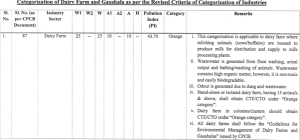


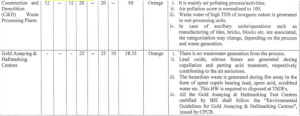
Both the Central Pollution Control Board (CPCB) and State Pollution Control Board (SPCB) have the authority to classify industries based on colour code into Red, Orange, Green and White. The categorisation takes into account the Pollution Index which assesses the overall polluting level of any industry. It ranks the industries on a scale ranging from 0 to 100; the increasing number on Pollution Index indicates the higher polluting potential of that industry. Red category industries generate the highest level of pollution, while White category industries generate negligible or no pollution. Each category has its own set of regulations that the industries must comply with.


 Incorrect
Incorrect
Answer: D
Explanation: Statement 1 is incorrect but statement 2 is correct.
The following industries are listed under Orange category industry by the CPCB. Orange category industries have a pollution index ranging between 41 and 59. They are relatively less polluting as compared to the Red industries, but relatively more polluting than the green and white industries.






Both the Central Pollution Control Board (CPCB) and State Pollution Control Board (SPCB) have the authority to classify industries based on colour code into Red, Orange, Green and White. The categorisation takes into account the Pollution Index which assesses the overall polluting level of any industry. It ranks the industries on a scale ranging from 0 to 100; the increasing number on Pollution Index indicates the higher polluting potential of that industry. Red category industries generate the highest level of pollution, while White category industries generate negligible or no pollution. Each category has its own set of regulations that the industries must comply with.




